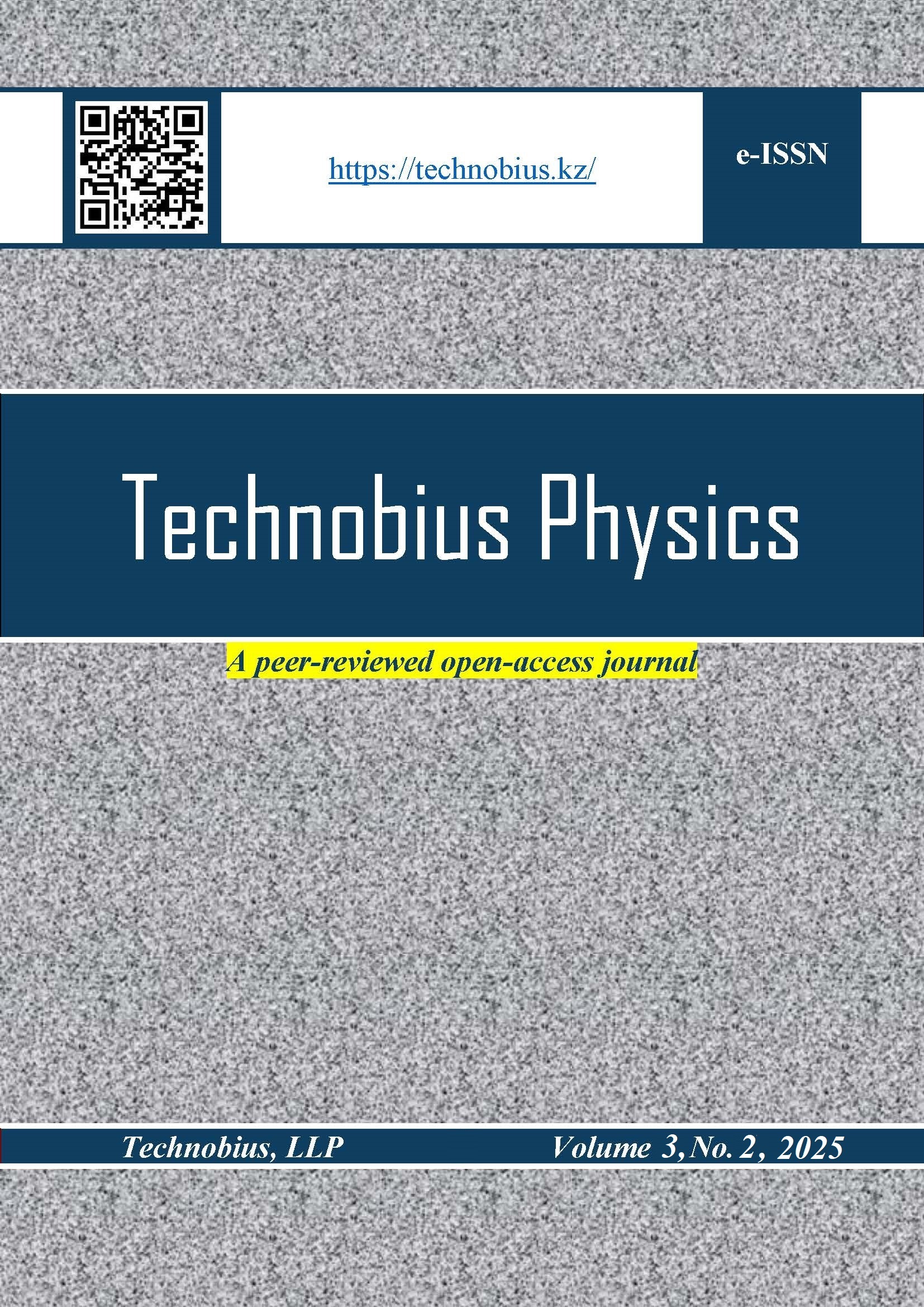Structural analysis of NaCl and CsCl via Debye–Scherrer powder diffraction
Retracted
DOI:
https://doi.org/10.54355/tbusphys/3.2.2025.0031Keywords:
X-ray diffraction, Debye-Scherrer method, crystal structure, sodium chloride, caesium chloride, lattice constantAbstract
Retraction Notice: This article has been retracted. The retraction statement is included at the end of the article. Referred to by: Retraction to “M. Brewer and A. Sheriyev, “Structural analysis of NaCl and CsCl via Debye–Scherrer powder diffraction”, tbusphys, vol. 3, no. 2, p. 0031, Jun. 2025. doi: 10.54355/tbusphys/3.2.2025.0031”
This study investigates the crystal structures of sodium chloride and caesium chloride through powder X-ray diffraction using the Debye-Scherrer method. The primary objective was to determine lattice types, calculate lattice constants, and estimate the number of atoms per unit cell based on experimental diffraction ring data. Powdered samples were exposed to X-rays, and the resulting ring patterns were analyzed to assign Miller indices and derive interplanar spacings. The evaluation of ring positions and intensities revealed that sodium chloride crystallizes in a face-centered cubic structure, while caesium chloride adopts a body-centered cubic arrangement. The calculated lattice constants were 562.0 pm for sodium chloride and 409.6 pm for caesium chloride, both in good agreement with standard reference values. Additionally, the number of atoms per unit cell was determined to be approximately four for sodium chloride and two for caesium chloride, consistent with their respective crystal symmetries. The study confirms the reliability of basic X-ray diffraction techniques for structural identification in ionic solids and highlights distinct diffraction trends corresponding to different cubic symmetries. These findings reinforce the effectiveness of the Debye-Scherrer approach in crystallographic education and rapid phase analysis, while also identifying opportunities for enhanced resolution through extended exposure or high-intensity sources.
Downloads
Metrics
References
K. Wang, W. Yang, X. Gao, and X. Wang, “Effect of preparation conditions on crystal size and pore structure of pseudoboehmite,” Tianjin Daxue Xuebao (Ziran Kexue yu Gongcheng Jishu Ban)/Journal Tianjin Univ. Sci. Technol., vol. 46, no. 10, pp. 934–938, Oct. 2013, doi: 10.11784/TDXB20131013.
K. C. Ross, J. A. Petrus, and A. M. McDonald, “An empirical assessment of two-dimensional (2D) Debye-Scherrer-type image-plate X-ray diffraction data collapsed into a 1D diffractogram,” Powder Diffr., vol. 29, no. 4, pp. 337–345, Jun. 2014, doi: 10.1017/S0885715614000487. DOI: https://doi.org/10.1017/S0885715614000487
H. Yanxon et al., “Artifact identification in X-ray diffraction data using machine learning methods,” J. Synchrotron Radiat., vol. 30, pp. 137–146, Jan. 2023, doi: 10.1107/S1600577522011274. DOI: https://doi.org/10.1107/S1600577522011274
S. H. Teh and I. I. Yaacob, “Synthesis and characterisation of electrodeposited iron-platinum nanostructured thin films,” Mater. Res. Innov., vol. 13, no. 3, pp. 199–202, Sep. 2009, doi: 10.1179/143307509X437617. DOI: https://doi.org/10.1179/143307509X437617
Y. Teshima and T. Matsumoto, “Continuous deformation of sphere-packing structures extending over simple, body-centered, and face-centered cubic lattices,” Glas. Phys. Chem., vol. 38, no. 1, pp. 49–54, Feb. 2012, doi: 10.1134/S1087659612010154. DOI: https://doi.org/10.1134/S1087659612010154
S. V. Karpenko, A. P. Savintsev, and A. I. Temrokov, “Anomalous behavior of surface characteristics of certain ionic crystals under high pressures,” Dokl. Phys., vol. 53, no. 3, pp. 128–132, 2008, doi: 10.1134/S102833580803004X. DOI: https://doi.org/10.1134/S102833580803004X
X. Wang et al., “Revisiting lattice thermal conductivity of CsCl: The crucial role of quartic anharmonicity,” Appl. Phys. Lett., vol. 124, no. 17, Apr. 2024, doi: 10.1063/5.0201393. DOI: https://doi.org/10.1063/5.0201393
H. Ling, J. Montoya, L. Hung, and M. Aykol, “Solving inorganic crystal structures from X-ray powder diffraction using a generative first-principles framework,” Comput. Mater. Sci., vol. 214, p. 111687, Nov. 2022, doi: 10.1016/J.COMMATSCI.2022.111687. DOI: https://doi.org/10.1016/j.commatsci.2022.111687
P. Tolédano, K. Knorr, L. Ehm, and W. Depmeier, “Phenomenological theory of the reconstructive phase transition between the NaCl and CsCl structure types,” Phys. Rev. B - Condens. Matter Mater. Phys., vol. 67, no. 14, Apr. 2003, doi: 10.1103/PHYSREVB.67.144106. DOI: https://doi.org/10.1103/PhysRevB.67.144106
Y. Liu et al., “Progress and challenges in structural, in situ and operando characterization of single-atom catalysts by X-ray based synchrotron radiation techniques,” Chem. Soc. Rev., Oct. 2024, doi: 10.1039/D3CS00967J. DOI: https://doi.org/10.1039/D3CS00967J
J. Santana-Andreo, H. D. Saßnick, and C. Cocchi, “Thermodynamic stability and vibrational properties of multi-alkali antimonides,” JPhys Mater., vol. 7, no. 3, Jul. 2024, doi: 10.1088/2515-7639/AD510B. DOI: https://doi.org/10.1088/2515-7639/ad510b
F. Logiurato, L. M. Gratton, and S. Oss, “Optical Simulation of Debye-Scherrer Crystal Diffraction,” Phys. Teach., vol. 46, no. 2, pp. 109–112, Feb. 2008, doi: 10.1119/1.2834534. DOI: https://doi.org/10.1119/1.2834534
“Introduction to Solid State Physics Charles Kittel,” 2005.
D. W. Snoke, “Solid State Physics: Essential Concepts,” Jan. 2020, doi: 10.1017/9781108123815. DOI: https://doi.org/10.1017/9781108123815
Downloads
Published
How to Cite
License
Copyright (c) 2025 Marry Brewer, Almas Sheriyev

This work is licensed under a Creative Commons Attribution-NonCommercial 4.0 International License.








